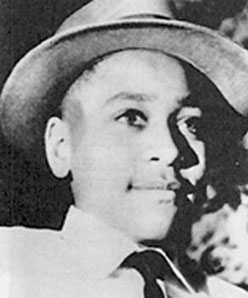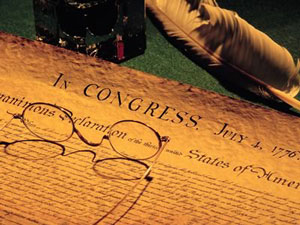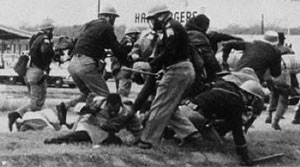
In the University of North Carolina at Greensboro Individual and Politics: Introduction to Political Psychology class, Assistant Professor Dr. Darlene Rodriguez, Ph.D., asked students to submit their reflections on a visit to the International Civil Rights Center and Museum. The students shared their eye opening impressions on a message board Dr. Rodriguez setup for that purpose. Using the DEAL Model, students were asked to provide answers to the following statements to define, describe, and explain their perceptions of the Civil Rights Center and Museum. Dr. Rodriguez encouraged students to respond to each other’s reflections as well.
- I learned that
- I learned this when
- This learning matters because
- In light of this learning
Maggy Sivansay  When I went to the museum on November 23, 2010 I experienced an experience that was quite similar to what the African-Americans went through by going through a maze in the museum from the beginning to the end of the tour. It made me have a sense of feeling of what the obstacles were for African-Americans and what they had to go through in order to pursue equality in our country. Also, at the museum I saw some disturbing pictures that made me feel uneasy and throughout the day I couldn't get one picture out of my head, it was the picture of Emmett Till. I couldn't believe grown men would act in so much rage that would harm a 14-year-old boy, that's just sad what society use to be and I would say some people still are racist.
When I went to the museum on November 23, 2010 I experienced an experience that was quite similar to what the African-Americans went through by going through a maze in the museum from the beginning to the end of the tour. It made me have a sense of feeling of what the obstacles were for African-Americans and what they had to go through in order to pursue equality in our country. Also, at the museum I saw some disturbing pictures that made me feel uneasy and throughout the day I couldn't get one picture out of my head, it was the picture of Emmett Till. I couldn't believe grown men would act in so much rage that would harm a 14-year-old boy, that's just sad what society use to be and I would say some people still are racist.
The museum visit was a place for me to learn some new things about racism and some of the things being said by the tour guide I already knew. But, to see videos and hear what happen in our history is sad and disturbing. I can but can't believe this happened and how certain people can hate a particular group so much that they would segregate and discriminate against them. Racism is wrong and it doesn't make anyone superior it just causes harm and take the lives of loved ones.
A quote by Fannie Lou Hamer, "I'm sick and tired of being sick and tired," really caught my eye, because I never understood the real concept behind this quote until I visited the museum. I took this quote and processed it as if an individual or group of individuals want to overcome a barrier. The individual(s) must make a move and pursue that goal and it doesn't matter how long it takes, because one man's move encourages plenty to do so, also. Basically, out of the whole museum visit this is what I mainly got out of it is in order to achieve the possible one must become the possible and do what's right for each human being in order for our society to progress.
Andy Tse  I visited the International Civil Rights Centre & Museum on Tuesday 16 November 2010. From the one-hour tour guided by a very experienced museum staff, I have learned many facts, both hidden and exposed.
I visited the International Civil Rights Centre & Museum on Tuesday 16 November 2010. From the one-hour tour guided by a very experienced museum staff, I have learned many facts, both hidden and exposed.
I learned that people are selfish. They would take advantage of the weak by enslaving them, even though those they enslaved are no different than themselves other than the color of their skin. The slave market was a great pillar of the US economy when some people voiced out that slavery should be abolished. This selfish nature was so powerful and hard to change that people resisted by military force against their fellow citizens and even their President. The US Civil War would not have happened if people were not so selfish about their economic and social interests.
I learned that the supreme document of a state could fail to guide people's behavior when they are overwhelmed by selfishness and emotions. The US Declaration of Independence explicitly states that 'all men are created equal' and 'they are endowed by their Creator with certain unalienable Rights, that among these are Life, Liberty and the pursuit of Happiness'. But at the time when slavery was still legal in the US, the Negros were definitely not equal with the Whites. The rights of the Negros to life, liberty, and pursuit of happiness were alienated (by other men). Even after the abolition of Slavery and the Negros were called African Americans, the country continued to witness segregation and discrimination against their black fellow citizens. The Constitution was there, but people acted their own way as if it did not exist.
 I learned that making change to a society to suppress people’s selfishness and bring them back to their behavior-guiding document is not easy and is a lesson of blood and pain. Lots of anti-slavery activists were brutally, innocently, and inhumanely treated. They were coerced and criminalized, beaten and burnt and murdered. These activists were not limited to the black activists but also included the white ones. I was startled when I saw the picture of which a white activist was murdered with his eyes cut out and limbs dismantled. I was even more upset and angry when the murderers were caught but not convicted guilty by a jury of the same kind. The legal system corrupted and the social order collapsed due to an ill-founded attitude — racism. When the day Martin Luther King was assassinated, I could not imagine how much blood had been lost to bring a stop to the society’s selfishness-driven slavery movement.
I learned that making change to a society to suppress people’s selfishness and bring them back to their behavior-guiding document is not easy and is a lesson of blood and pain. Lots of anti-slavery activists were brutally, innocently, and inhumanely treated. They were coerced and criminalized, beaten and burnt and murdered. These activists were not limited to the black activists but also included the white ones. I was startled when I saw the picture of which a white activist was murdered with his eyes cut out and limbs dismantled. I was even more upset and angry when the murderers were caught but not convicted guilty by a jury of the same kind. The legal system corrupted and the social order collapsed due to an ill-founded attitude — racism. When the day Martin Luther King was assassinated, I could not imagine how much blood had been lost to bring a stop to the society’s selfishness-driven slavery movement.
The U-turn, however, did not come until the presence of a few courageous leaders who used a very practical and sensible way of struggle to gain public support. I was surprised that it was four college students who initiated the U-turn. Their campaign of ‘sit-down and demand for service’ in lunch counters was practical because other black (and white) students could easily join them by spending their time studying there during the ‘sit-down’ period. It was also sensible because the loss of white customers and hence loss of revenue would eventually leave the owners of the restaurants no choice but to accept African Americans as their customers and provide services to them to avoid business closure. If you asked me why these few student leaders succeeded but their other predecessors failed, I would say it is the combination of courage, wisdom, and the firm belief that small-potato individuals can make a difference to the society — lacking any of these factors would inevitably lead to failure.
The segregation and discrimination against African Americans were manifested from nearly every aspect of social life. For example, African Americans were only allowed to sit in the back of a bus, where the facilities were poorer and the location was less convenient for boarding and de-boarding. Also, black people were not allowed to vote and hence participate in administering public affairs. The most impressive example to me is the Coca-Cola vendor machine, which sold a same drink to white people for 5 cents but to black people for 10 cents. Other examples include the lack of schools, restaurants, hotels, and hospitals for the black community.
Editors Note: These are just a few of the reflections turned in by students, simply follow this link to download the complete PDF file at no cost.

Comments
ACU Civil Rights Tour May 15-21
Hello Dr. Rodriquiz,
Three ACU professors (one of which is myself) will be taking between 25-30 ACU students on an 1800 mile tour through the south, May 15 - 21st.
I anticipate this experience will generate similar reflections that you have shared here. I am currently working on the syllabus and assembling a "daily reflection journal" for each student to record various aspects of each days agenda.
We, too, will visit the Civil Rights Center, one of many stops at civil rights memorials, museums, churches, and a bridge or two.
I have been pondering different types of "reflection questions" for the student journal, and I am very impressed with the simplicity of the statements you asked your students to address, as I can clearly see the depth of thought each statement produced.
With your permission, I would like to incorporate your four statements into the journal I am preparing, and perhaps after our ACU trip we can compare a few student responses.
I appreciate your insight,
Dr. Jennifer Dillman
REPLY - RE: Reflection Journal
dear dr. dillman (jennifer):
i am delighted to learn that our reflection exercise and the manner in which was facilitated interested you. feel free to use the questions to guide the reflection for your students as they travel to the international civil rights center and museum as well as other locations during your travels. if you would like to know more about these questions and the process of using critical reflection -- i would recommend using the "DEAL Model," which is where these guiding questions come from. to obtain additional information, feel free to review: Ash, Clayton, & Moses. Teaching and Learning through Critical Reflection, it will provide you with a thorough review of the DEAL Model.
enjoy the end of term -- and safe travels!
should you have any additional questions, feel free to let me know.
i remain, always, dr. rodriguez (darlene)
I wish that SBU had one of
I wish that SBU had one of these programs. I feel like we could learn a lot from this experience in our World Views class, which deals with the topic of racism. I think that the best part of these descriptions is noticing how extreme racism was, and seeing how it has progressed into present racism.